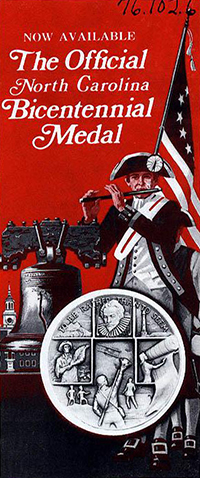American Revolution Bicentennial Observance
 The American Revolution Bicentennial Observance in North Carolina in 1976 involved many different events and was preceded by several years of planning. A state agency, the North Carolina Bicentennial Commission, was created in the Division of Archives and History of the Department of Cultural Resources, and it worked throughout the state to help plan the nation's 200th anniversary celebration. Individuals and organizations planned and carried out programs of social, historic, and artistic interest. Five major events of statewide historic significance took place during the bicentennial year. These included events commemorating the Battle of Moore's Creek Bridge (27 Feb. 1776), the Halifax Resolves (12 Apr. 1776), the Battle of Guilford Courthouse (15 Mar. 1781), the Fourth of July, and the Battle of Kings Mountain (7 Oct. 1780), jointly observed with South Carolina.
The American Revolution Bicentennial Observance in North Carolina in 1976 involved many different events and was preceded by several years of planning. A state agency, the North Carolina Bicentennial Commission, was created in the Division of Archives and History of the Department of Cultural Resources, and it worked throughout the state to help plan the nation's 200th anniversary celebration. Individuals and organizations planned and carried out programs of social, historic, and artistic interest. Five major events of statewide historic significance took place during the bicentennial year. These included events commemorating the Battle of Moore's Creek Bridge (27 Feb. 1776), the Halifax Resolves (12 Apr. 1776), the Battle of Guilford Courthouse (15 Mar. 1781), the Fourth of July, and the Battle of Kings Mountain (7 Oct. 1780), jointly observed with South Carolina.
Other activities and celebrations were staged across the state. A Bicentennial Mall in Raleigh (between the State Capitol and the state legislative buildings) was completed and became the site of a time capsule containing items made in the state. (The capsule, containing a Bic pen, Salem cigarettes, cellophane tape, razor blades, L'eggs pantyhose, Goody's headache powder, and other objects, is to be opened at the nation's tricentennial.) Newspapers, magazines, and radio and television stations generously covered events in local areas and across the state. In Durham, the Greater Durham Chamber of Commerce sponsored a Bicentennial Folk Life Festival. The North Carolina Symphony and other musical groups performed several times throughout the year, and a symphony and an opera were composed and performed for the bicentennial celebration.
The bicentennial also sparked publication of a number of works on North Carolina, many of which remain in print and are influential for their contribution to the history of the state. Examples of these include the first comprehensive history of North Carolina's colonial period, Colonial North Carolina, by Hugh T. Lefler and William S. Powell, published in 1973 as a volume in Scribner's History of the American Colonies series; and the state's official bicentennial book, a history of North Carolina before the Revolution titled Spirit up the People: North Carolina, the First Two Hundred Years, written by Taylor Lewis and Joanne Young and published in 1975.
Reference:
North Carolina Bicentennial Commission, North Carolina Bicentennial Newsletter, vols. 1-3 (1973-76).
Additional Resources:
"An Act to Establish the North Carolina American Revolution Bicentennial Commission." Session laws and resolutions passed by the General Assembly. Winston-Salem, N.C.: Winston Printing Company. 1967. p.104-105. https://digital.ncdcr.gov/Documents/Detail/session-laws-and-resolutions-passed-by-the-general-assembly-1965-1967/4204399?item=4205284 (November 2, 2012).
Image Credits:
"Commemorative Medal, Accession #: H.1976.102.6." 1976. North Carolina Museum of History.
1 January 2006 | Williams, Wiley J.